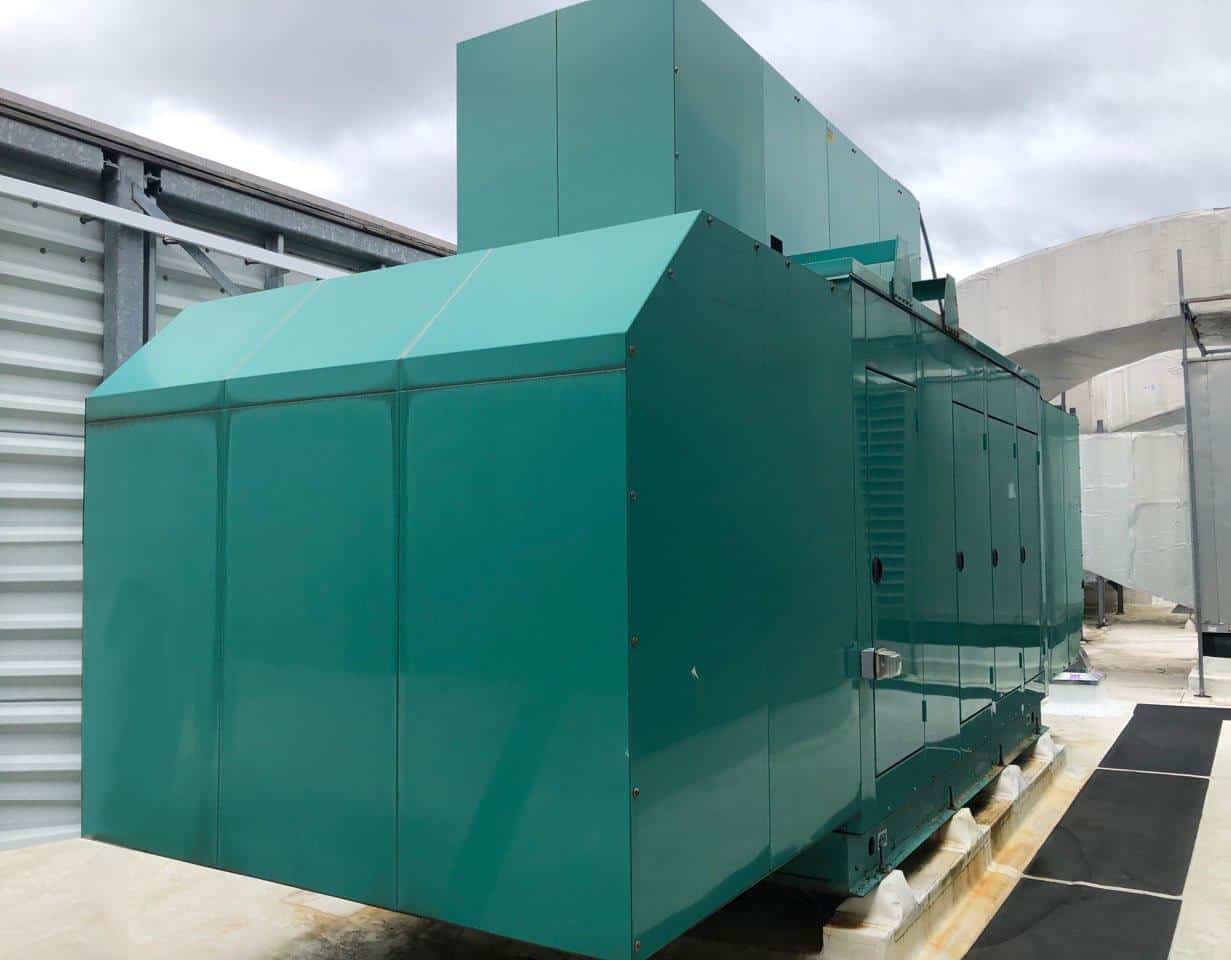Using Natural Gas Generators to Power a Grid

When it comes to backup generators, both diesel and natural gas generators are well-known for being used in a variety of applications to provide backup power to businesses and facilities in the event of power outage or even serve as the primary source of power for operations and applications that take place off the main power grid, but what about using natural gas generators to serve as a remote or temporary power grid?
Why Natural Gas Generators?
Natural gas generators make a great solution for grid applications, because out of all the current alternative power solutions available (alternative meaning not part of the main power grid), these generators are one of the most reliable sources of constant power. Depending on build and configuration, natural gas generators can run in continuous or prime applications to act as a primary power supply and kW output can be added to meet power requirements by running generators in parallel. This makes the ease of application simpler when compared to wind, solar, or other products that require a much larger footprint and possess less efficiency or reliability when compared to a natural gas generator for constant power. An added plus If you already have a natural gas fuel supply available on-site, it is considerably cheaper to run a natural gas generator when compared to running a generator on diesel.
One of the key benefits of a natural gas generator is that they are much more environmentally friendly in comparison to their diesel counterparts, because there are no emission requirements that need to be met (except in the state of California which requires CARB certifications). Typically, natural gas generators also run for longer periods of time and are more durable on the industrial side as long as they are well-maintained. While there are some downsides to using natural gas generators, such as a potential fuel supply cutoffs in the event of a natural disaster or the overall higher cost of natural gas generators when compared to diesel, the benefits far outweigh the downsides especially in the case of long-term applications.
That is to say that diesel generators come with their own benefits as well, such as the ability to obtain a constant supply of power via attached diesel base tanks and external diesel fuel tanks. This means that diesel fuel can always be added to the fuel storage tank in order to run the generator in case of emergencies, such as natural disasters when natural gas supplies may be cut off. While this is considered a major benefit, it can also pose a challenge, as depending on the severity of the natural disaster – replenishing diesel fuel by securing fuel delivery can prove difficult.
Setup Process
While the ease of application for natural gas generators is simpler when compared to other alternative power solutions available in the market, there is still a process involved when setting up these generators for grid applications. Each application site and project will differ from one another, so we’ll provide a general guideline to the process that is usually followed:
- The first step would be to conduct an electrical study on the site. The electrical study would involve itemizing ideal power requirements to power the application, mark installation points, trenching distances for cable for long applications, and assess the scope of work. This would typically require an electrical engineer, a couple generator technicians, and a power plant engineer to successfully complete this scope of work.
- The next step would be to order the generator and all related equipment/accessories, setting up site foundation like a concrete pad, applying for all required and necessary permits, laying out the foundation for all equipment that will be installed like routing cables, building out the electrical circuit to accept generator power within the facility, connecting the generator to the natural gas fuel supply, ensuring there is proper clearance for the generator or if installing the generator indoors within a generator room – establishing proper ventilation for the generator to ensure safety of all technicians, employees, and visitors.
Equipment Needed
When it comes to required equipment, each facility and project location will require different equipment in order to setup a power grid using natural gas generators, which makes each case unique. Although each individual case may be unique, they often share many equipment requirements in most cases. So let’s use an example:
- Suppose you’re putting together a 2 mW (2000 kW) powered microgrid, we would either choose to go with four 500 kW units or two 1 mW (1000 kW) units running in parallel depending on the available space and site requirements. Although something like this can be achieved with just one machine, it is often ill advised to rely on one generator engine for this type of application. The main reason for this being redundancy. In the case that one generator engine fails, the other generator(s) can continue to operate and ensure that power to the application can continue to be provided as repairs are being conducted to the unit experiencing failure.
- You would also need transformers to control the voltage output from the generator to the grid
- Transfer switches for the generators that can prompt the generators when to run and when to shut off
- Most importantly, you will need a paralleling system that is either going to be done via a “come in” bus or through the generators themselves
How Much Gas Would I need to Run the Generator at Full Capacity?
Fuel consumption varies depending on actual use and power requirements, so let’s take a look at an estimated example of running two 1 mW (1000 kW) units at full load to meet a 2 mW (2000 kW) grid requirement.
Assuming we run a 1 mW (1000 kW) natural gas generator at full load and base the fuel consumption on 1015 BTU/standard ft³ of natural gas, then it would consume approximately 12,780 BTU per ft³ per hour at full load. If we were to apply this to our example of a 2 mW (2000 kW) powered microgrid application, this would double the value of 12,780 BTU and leave us at 25,560 BTU per ft³ per hour at full load.
Since every project has different requirements, natural gas fuel consumption may vary. It’s best to reference generator specification charts to ensure that you’re calculating estimated fuel consumption as closely as possible.
Calculating kW Output Per Hour
Now when it comes to calculating kW output per hour, there is a formula that is followed when making these types of calculation, which is:
E(kWh) = P(kW) × t(h)
E is the energy in kilowatt-hours (kWh). This is equal to P, which is power in kilowatts (kW) and is multiplied by t, which is the time period in hours (h).
Let’s reference the 2 mW (2000 kW) power grid example we have been using. Assuming that the power output is 2000 kW and we’ll estimate the time to be one month, we’ll have the following values:
P = 2000 kW
t = 720 hours
Now we’ll plug it into the formula:
E = 2000 kW x 720 hours
2000 kW x 720 hours = 1,460,000 kilowatt-hours
When calculating kW output per hour, this is a great formula to leverage when making calculations to estimate cost vs output.
There are many factors to consider when running natural gas generators for large applications such as power grids, but these are the general items to keep in mind before starting such a large scale project. As always, we advise you to work with experts in the industry to ensure that all safety precautions, power, and equipment requirements are met to successfully complete the project.
If you’re looking to setup a powered micro grid or looking for a company to work with on this type of project, but don’t know where to start? Reach out to us at Woodstock Power Company!
610-658-3242
Or fill out our Contact Form and our representatives will get back to you shortly!
THE WOODSTOCK POWER COMPANY EXPERIENCE
We have industry experts that focus on commercial generator sets, with in-depth industry knowledge to help you choose the right generator that fits your needs.
We are industry leaders in buying and selling used generators to fit the needs of many businesses, including commercial, industrial, medical, agricultural, and university. This includes facilities like hospitals, better living centers, nursing home, airports, hotels, resorts, restaurants, retail centers, manufacturing, production, and more.
Our experts are ready to assist you from answering any questions you may have about power generator sets to helping you find the best selection in our inventory based on:
- Peak & Average Power Requirements
- Fuel Preference (Natural Gas or Diesel)
- Portability & Stationary Power
- Prime & Standby Generator Requirements
- Available Space & Exhaust Restrictions
We carry only the most top rated new, used, and surplus power generator sets for sale, providing you with a great value generator that will fit your budget.
Our generators have been thoroughly inspected, serviced, and verified, which ensures that you will be buying a quality generator that you can depend on. If a generator is not up to par with industry standards, we make all necessary repairs or modifications, and fully test every generator before we sell. This ensures a full turnkey generator that’s ready to fire up and go!
Due to our wide selection of generator sets, we’re confident that we can find the model that best suits your operational needs and budget.
We also buy used generators in good quality, if you have already upgraded and you’re looking to sell your older model.
Feel free to contact us with any questions, concerns, or inquiries to learn more about the Woodstock Power Company experience and the quality level of products & services we provide.

